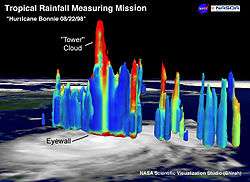Hot tower
A hot tower is a tropical cumulonimbus cloud that reaches out of the lowest layer of the atmosphere, the troposphere, and into the stratosphere. In the tropics, the border between the troposphere and stratosphere, the tropopause, typically lies at least 15 kilometres (9.3 mi) above sea level. These formations are called "hot" because of the large amount of latent heat released as water vapor condenses into liquid and freezes into ice.[1] The presence of hot towers within the eyewall of a tropical cyclone can indicate possible future strengthening.

Origin of term
The hot tower hypothesis was proposed in 1958 by Herbert Riehl and Joanne Simpson after extensive study of moist static energy profiles in the tropics.[2] Prior to 1958, the mechanism driving atmospheric Hadley cells was poorly understood. Riehl and Simpson proposed that the energy feeding these convective cells was supplied by the release of latent heat during condensation and subsequent freezing of warm, moist air in areas of convection about 5 kilometres (3.1 mi) wide. The large horizontal extent of these convective cells provides a buffer from the dry air surrounding the convective region that allows the parcel to rise at nearly the moist adiabatic lapse rate. NOAA also defined the term Towering cumulonimbus in 2009.[3]
Effects on tropical cyclones
In 2007, the National Aeronautics and Space Administration (NASA) hypothesized that the wind shear between the eye and the eyewall could enhance updraft through the center of a cyclone and generate convection.[4] Hot towers may appear when a cyclone is about to intensify, possibly rapidly. A particularly tall hot tower rose above Hurricane Bonnie in August 1998, as the storm intensified before striking North Carolina.[5]
See also
References
- Riehl, Herbert; Malkus, Joanne (1958). "On the heat balance in the equatorial trough zone". Geophysica. 6 (3–4): 503–538.
- Zipser, Edward J. (2003). "Some Views On "Hot Towers" after 50 Years of Tropical Field Programs and Two Years of TRMM Data". Meteorological Monographs. 29 (51): 49–58. Bibcode:2003MetMo..29...49Z. doi:10.1175/0065-9401(2003)029<0049:CSVOHT>2.0.CO;2.
- Chohan, Rani (2004-01-12). "Scientists Discover Clues to What Turns a Hurricane into a Monster". Retrieved 2009-01-07.
- ""Hot Tower" Hypothesis". NASA Earth Observatory. Retrieved 2008-08-28.
- Towering cumulonimbus
- National Aeronautics and Space Administration (2007). "Hot towers simulation". NOAA. Retrieved 2009-09-18.
- National Climatic Data Center (1998). "Bonnie Buffets North Carolina!". NOAA. Archived from the original on 2008-09-16. Retrieved 2009-01-07.
External links
- Hurricane Multimedia Gallery. - A Hurricane Multimedia page.
- UCAR slides: "Hot Towers and Hurricanes: Early Observations, Theories and Models"